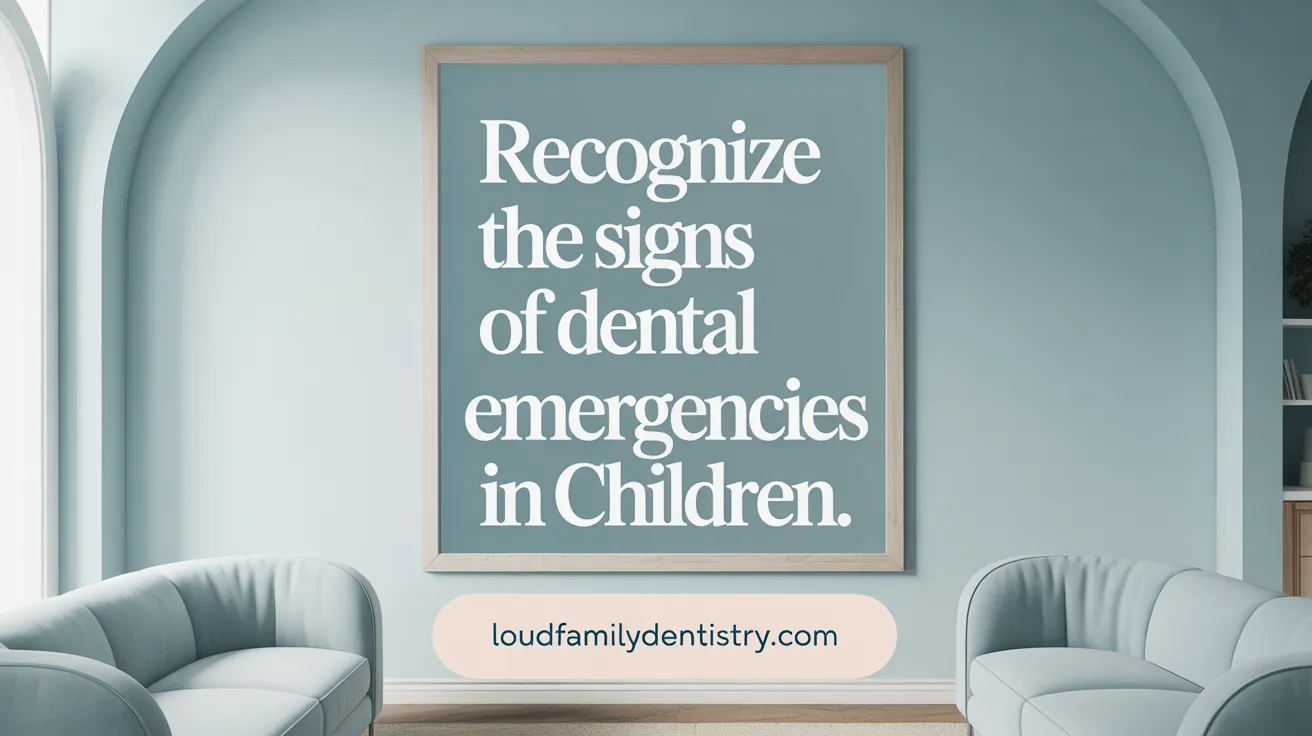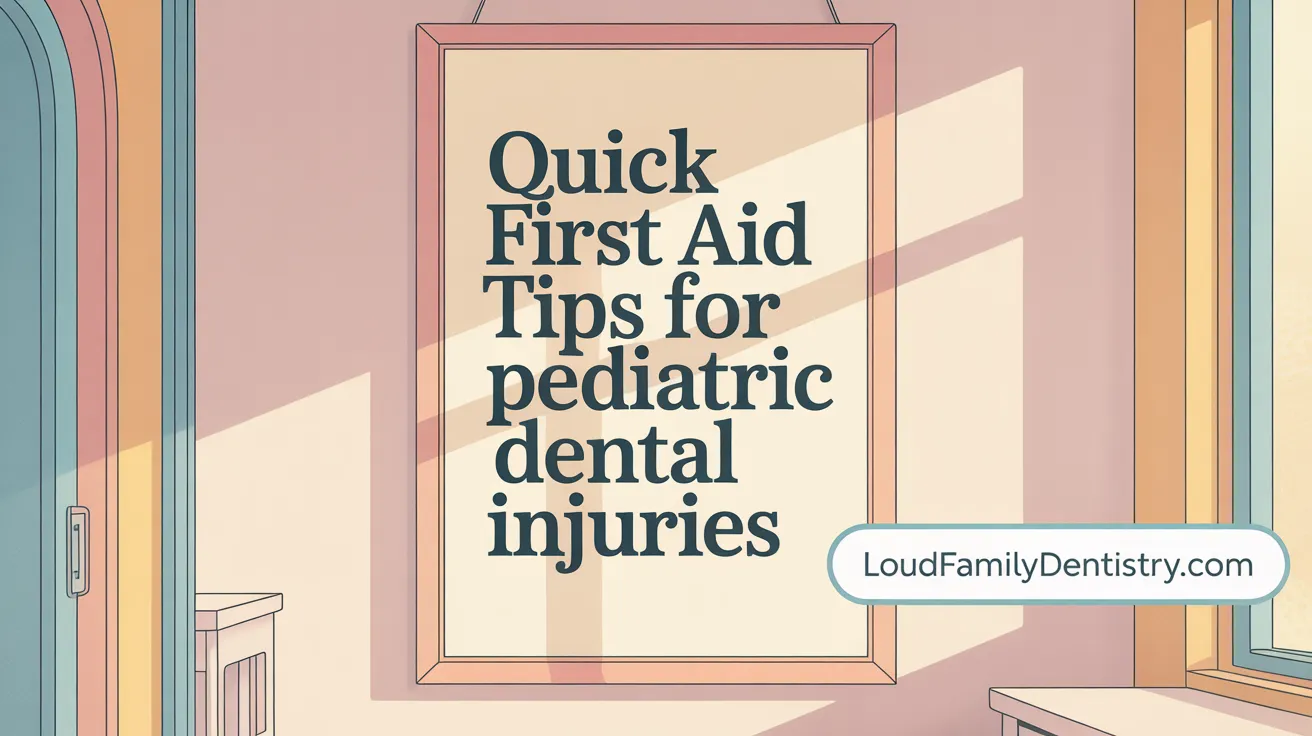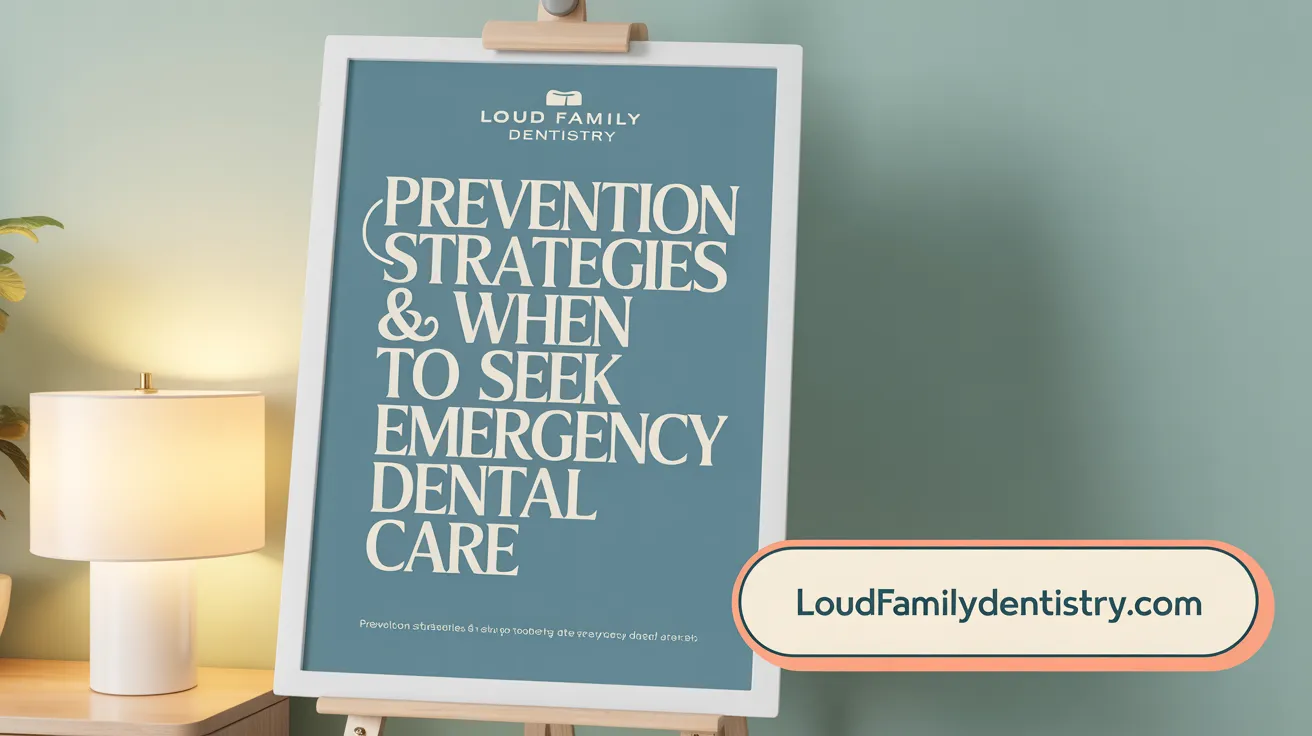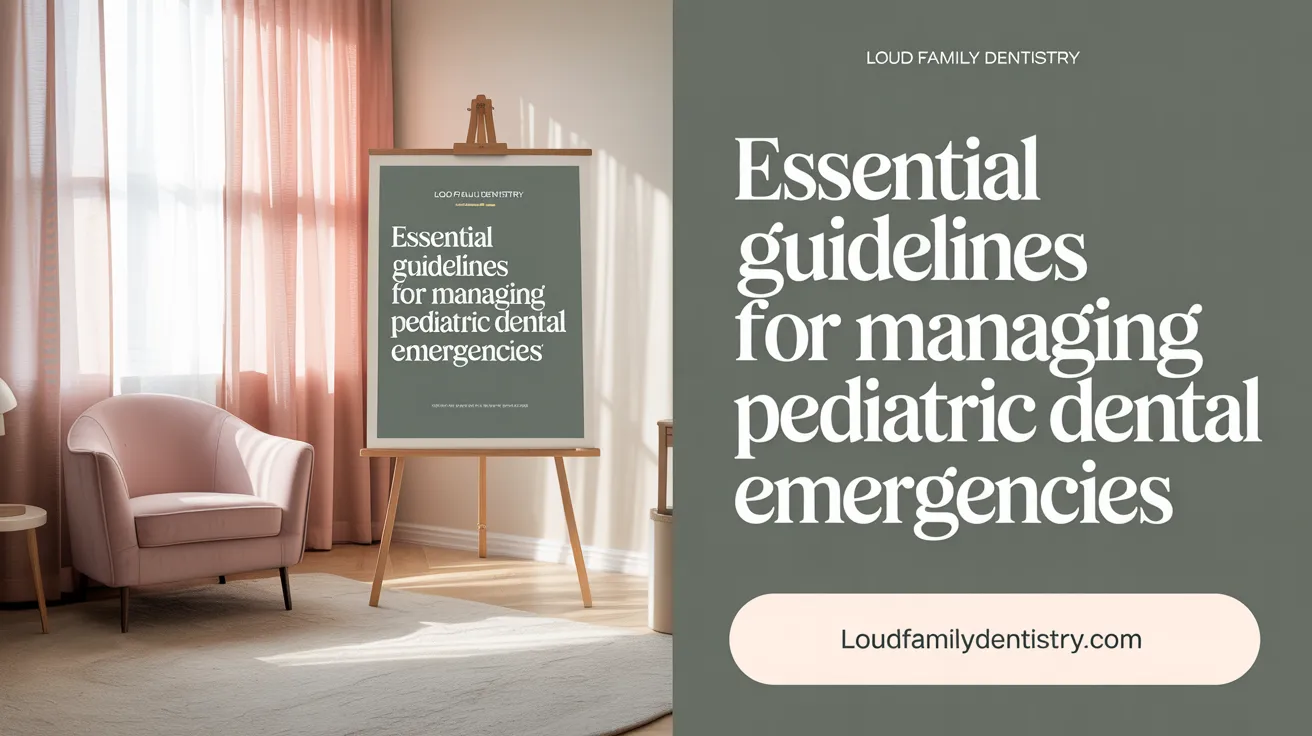Understanding the Urgency of Pediatric Dental Emergencies
Dental emergencies in children can be alarming and stressful for parents and caregivers. Timely recognition and appropriate management of these situations are critical to preserving dental health and preventing long-term complications. This article provides comprehensive guidance on common types of pediatric dental injuries, immediate first aid steps, treatment options, preventive strategies, and resources to equip parents for handling dental emergencies effectively.
Common Pediatric Dental Emergencies and Recognizing Their Signs

What are the most common pediatric dental emergencies?
Children are susceptible to various dental emergencies, especially during active play, sports, or accidental falls. Among the most frequent issues are knocked-out teeth, whether primary (baby) or permanent teeth. Fractured or chipped teeth are also common, often resulting from biting on hard objects like ice or candies.
Dental infections, such as abscesses, can cause intense pain and swelling, requiring urgent intervention. Soft tissue injuries, including cuts to the gums, lips, or tongue, are frequent, especially in falls or during sports.
Additionally, children might experience loose teeth, dental pain from cavities, or the loss of crowns or fillings. Preventive measures like mouthguards during sports and regular dental checkups can significantly reduce these risks.
In cases involving knocked-out permanent teeth, prompt action -- ideally within 30 minutes -- can improve the chances of saving the tooth. Severe pain, facial swelling, or uncontrollable bleeding are signs to seek immediate medical attention.
Signs and symptoms of dental injuries
Parents should watch for signs such as bleeding from the mouth, swelling, and pain. Visible fractures or chips in the teeth, looseness, or the complete loss of a tooth are clear indicators of injury. Children may also experience difficulty chewing, biting, or showing discomfort when opening or closing their mouths.
More subtle symptoms include changes in tooth color, increased sensitivity, or a child guarding their mouth. If a child exhibits facial swelling, persistent bleeding, or if bleeding does not stop after applying pressure for about 10 minutes, emergency care is necessary.
Signs of infection—such as a fever, foul taste, or increasing swelling—also indicate complications needing urgent attention. For detailed first aid and treatment of these injuries, refer to Treating Oral Injuries.
Causes of dental trauma in children
Most dental injuries stem from falls, sports accidents, or biting onto hard objects. Young children, especially between ages 2-4 and 9-10, are more prone due to their developing coordination and exploration behaviors.
Sport activities without proper mouth protection, rough play, and accidents at home or outdoors contribute significantly to dental trauma.
Preventative strategies include child-proofing the environment, using mouthguards during sports, and teaching children safe play habits. Regular dental visits can help identify early issues and reinforce protective practices. See Importance of Regular Dental Checkups for more information.
Immediate First Aid for Common Dental Injuries in Children
 When a child experiences dental trauma, quick and proper first aid can make a significant difference in outcomes.
When a child experiences dental trauma, quick and proper first aid can make a significant difference in outcomes.
First, gently rinse the child's mouth with warm water to clear away blood or debris. This step helps prevent infection and allows for a clearer assessment of the injury. For more on managing debris and oral cleaning, see Removing object caught between child's teeth.
If there is bleeding, apply gentle pressure with a clean cloth, gauze, or cotton ball to control it. Hold the cloth steady until the bleeding slows and stops. To reduce swelling, place an ice pack or cold compress on the outside of the mouth or face near the injury site. For detailed bleeding management, review Handling bleeding in mouth and First aid for dental bleeding.
Handling knocked-out permanent teeth requires careful attention. Find the tooth and handle it by the crown (the chewing surface), avoiding the root. Rinse it briefly with saline, milk, or saliva only if dirty. If possible, reinsert the tooth into the socket gently and hold it in place by biting down on gauze or a clean cloth. This must be performed quickly, ideally within 15 to 30 minutes, to maximize the chance of saving the tooth. Comprehensive guidance is available at Handling a knocked-out permanent tooth and Emergency steps for a knocked-out tooth.
If reimplantation isn't feasible, store the tooth in a medium that keeps it moist, such as milk, saline, or saliva, until professional dental assistance is available. See Knocked-out tooth care and Storing a knocked-out tooth for storage tips.
In cases of dislodged or loose teeth, guide the tooth back into its socket if feasible and comfortable for the child. Be gentle to prevent further damage. Apply a cold compress to reduce swelling. For more on managing loose teeth and dental trauma, consult Managing loose teeth in children and Care for loosened or pushed teeth.
Additionally, always check for signs of head or facial injury. Signs such as unconsciousness, loss of balance, or severe facial swelling require immediate medical attention. Call emergency services if necessary. Learn more at Signs of severe dental infection and swelling and Emergency services for head trauma.
By following these initial steps, parents can stabilize the injury, reduce pain and swelling, and improve the chances of a successful dental outcome. Additional useful resources for parents include Little Teeth, Big Emergencies: Make a Plan for Dental Crises and Kids' Dental Emergencies and What to Do Right Away.
Distinguishing Types of Dental Injuries and Their Treatments
 Understanding the differences among various dental injuries is crucial for effective treatment and prompt care. Dental injuries range from minor chips and cracks to more severe conditions like avulsions (knocked-out teeth), root fractures, and soft tissue lacerations.
Understanding the differences among various dental injuries is crucial for effective treatment and prompt care. Dental injuries range from minor chips and cracks to more severe conditions like avulsions (knocked-out teeth), root fractures, and soft tissue lacerations.
Differentiating injuries by severity and type involves observing their appearance and location. Chips and cracks typically affect the enamel and are visible as minor surface damages. Displaced or luxated teeth appear out of alignment but remain within the socket. Avulsions involve complete displacement of the tooth from its socket, often accompanied by bleeding and tissue swelling. Soft tissue injuries include cuts or tears in the gums, lips, or tongue.
Treatment options for these injuries vary based on severity:
| Injury Type | Treatment Approach | Additional Considerations |
|---|---|---|
| Chips & Cracks | Bonding, crowns, or veneers | Preserve tooth structure and aesthetics |
| Displaced (Luxated) | Reposition and splint | Stabilize the tooth, monitor vitality |
| Avulsions (Knocked-out) | Replant immediately if possible; store in milk or saliva | Urgent care needed within 30 minutes for best success |
| Root Fractures | Root canal therapy or extraction | Depends on fracture location |
| Soft Tissue Injuries | Clean, suture if necessary, control bleeding | Watch for signs of infection or complications |
Long-term care and follow-up are essential after initial treatment. Regular dental visits allow monitoring of healing, assessment of pulp vitality, and detection of any developing issues such as infection or misalignment. In cases of avulsion, a space maintainer may be necessary to preserve jaw alignment and space for permanent teeth.
In sum, differentiating dental injuries by their appearance and severity guides appropriate intervention. Whether handling minor chips or urgent avulsions, timely professional care ensures the best outcomes and long-lasting oral health for children. For further guidance, see resources on pediatric dental emergencies and managing knocked-out teeth.
Prevention and When to Seek Professional Care

What preventive measures can be taken to reduce the risk of dental emergencies in children?
To reduce the likelihood of dental emergencies, parents and caregivers can adopt several proactive strategies. Regular use of mouthguards during sports activities provides a critical barrier against knocks and injuries. Ensuring children are supervised to prevent biting or chewing hard objects, such as ice, popcorn kernels, or candies, helps avoid chipped or broken teeth. Maintaining excellent oral hygiene by brushing twice daily, flossing, and visiting the dentist every six months can prevent cavities and infections that sometimes lead to urgent issues.
Limiting sugary snacks and drinks reduces the risk of decay, which weakens teeth and makes them more prone to breakage. Teaching children about the importance of not using teeth to open packages or biting inappropriately can also prevent injuries. Creating a safe environment at home by reducing hazards that might cause falls or facial injuries is equally crucial.
Early intervention for dental issues, including prompt treatment for minor injuries, helps prevent more complicated emergencies later. Regular check-ups allow dentists to identify potential problems before they become emergencies, ensuring children’s oral health remains protected.
Guidelines on seeking urgent dental care
Immediate dental attention is vital in cases of knocked-out teeth, especially permanent ones, where treatment within 30 minutes significantly improves the chance of saving the tooth.
Severe or ongoing toothaches, especially when associated with swelling, fever, or pus, require prompt evaluation to address underlying infections. Persistent bleeding beyond 15 minutes despite applying pressure, or facial swelling that impairs breathing or swallowing, warrants urgent care.
Broken or chipped teeth should be examined promptly to evaluate for nerve exposure or fractures. Dental emergencies also include soft tissue injuries such as cuts or bites that do not stop bleeding after 15 minutes or are heavily bleeding.
If a dental appliance, like a crown or filling, falls out or is damaged, a prompt visit to the dentist helps prevent further damage or infection.
Importance of regular dental visits and protective gear
Regular dental visits not only help in early detection of potential issues but also serve an educational role in reinforcing good oral hygiene practices.
Using appropriate protective equipment, such as mouthguards during sports, significantly reduces injury risk. Custom-made mouthguards provide the best fit and protection, emphasizing the importance of professional guidance in choosing protective gear.
Combining preventive measures with regular professional care ensures that children stay healthier and are less likely to experience urgent dental problems, helping them maintain a lifetime of healthy smiles.
Managing Pediatric Dental Emergencies: Guidelines and Resources for Parents and Caregivers

What procedures and guidelines should be followed when managing dental injuries before professional help arrives?
In dental emergencies involving children, immediate first aid is crucial to prevent further damage and improve prognosis. The first priority is ensuring the child’s overall safety and addressing any life-threatening injuries such as severe bleeding, difficulty breathing, or facial trauma (Pediatric dental emergencies, Emergencies in Olympia).
For dental-specific issues, control bleeding by applying gentle pressure with sterile gauze (First aid for dental bleeding, Handling bleeding gums in children). If a tooth is knocked out, handle it by the crown (the top part), rinse it lightly with milk or saline without scrubbing, and attempt to reinsert it into the socket if possible (Handling a knocked-out tooth, How to handle a knocked-out tooth). If re-insertion isn’t feasible, store the tooth in a suitable medium like milk or saliva, keeping it moist until professional care can be provided (Storing a knocked-out tooth, Preserving a lost tooth in milk or saliva). It’s best to seek urgent dental care within 20-30 minutes, as this increases the likelihood of saving the tooth (Emergency steps for a knocked-out tooth, Immediate dental care for knocked-out teeth).
Assess soft tissue injuries for cuts or lacerations, and manage them with careful cleaning and pressure (Treating Oral Injuries, Handling Tongue or Lip Injuries). Keep the child calm, reassure them, and prevent them from eating or drinking until evaluated (Managing dental emergencies in children, Emergency steps for knocked-out baby tooth). Avoid using sharp objects or attempting complex procedures (Removing object caught between child's teeth, Removing broken dental appliances). Once stabilized, arrange for immediate follow-up with a pediatric dentist or oral surgeon (Pediatric emergency dentist in Canton, GA, Pediatric Dentistry at Lurie Children’s Hospital). Systematic assessment and proper handling are essential to ensure effective care and reduce long-term complications (Dental emergency triage and stabilization, Child dental emergencies).
Equipping Families for Effective Dental Emergency Response
Handling a child’s dental emergency with confidence and knowledge can significantly impact the outcome of the injury and preserve oral health. Understanding common injuries, applying appropriate first aid, recognizing when to seek professional care, and promoting preventive measures all empower parents and caregivers to navigate dental crises effectively. Utilizing available educational resources and maintaining open communication with dental professionals ensure that children receive timely and specialized care. Preparedness, calm action, and ongoing oral health vigilance are the best defenses against the challenges of pediatric dental emergencies.
